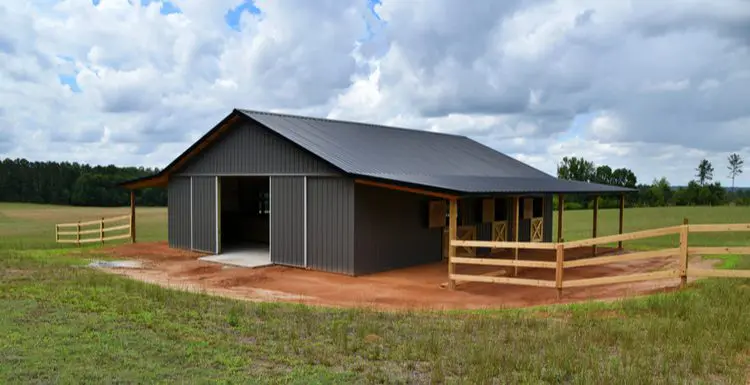Combining flexibility and efficiency, you can’t measure the return on investment against the pole barn cost.
But you can get an idea of what you’ll need to spend. We’ve rounded up average pole barn prices from across the country.
What Is a Pole Barn?
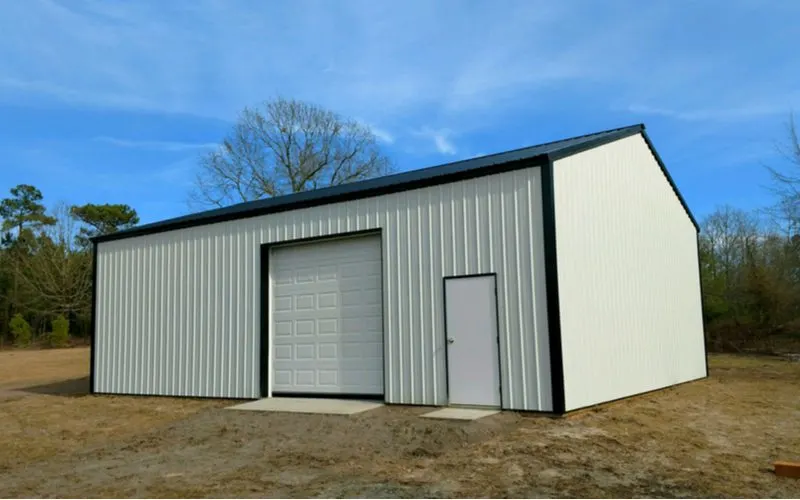
3queens_aJack/Shutterstock
The origin of pole buildings comes from a centuries-old construction technique. Posts are framing members buried a few feet into the ground, serving as the foundation of the entire building.
The types of pole structures include:
- Sheds: a building for smaller properties, typically used for equipment and tool storage.
- Houses: pole barn structures that have flooring, and other features for livability.
- Garages: Outbuildings that provide extra workspace and store vehicles.
The complexity of a project always impacts its cost. The location and landscape have a considerable influence on how the project is approached and budgeted.
Site accessibility is another factor that affects the bottom line. The right spot will be critical, as you need ground that can maintain pole stability.
Average Cost of Pole Barn
Pole barn installation is a form of post-frame construction. Post-frame builds have no foundation. Instead, they use vertical poles for structural stability. Production is usually easy, with low costs and adaptability.
The cost to build a pole barn runs as low as $4,000 and goes into the low six figures. A typical project averages about $25,000.
Size plays the most significant role in the cost. Expect to spend $20–$35 per square foot. These expenses don’t include materials or labor.
Pole barn prices also vary based on how an owner plans to use the structure. For example, if the barn is simply for storage, you’re looking at the low end.
If you have livestock, increase your estimates to accommodate flooring, doors, and insulation. Add in a loft and/or porch and you’re looking at $50,000, at the very least.
Average Pole Barn Prices
The average pole barn cost varies depending on how large of a structure you plan to build. Based on square footage, a 20-by-30-foot pole barn that can house two horses or one car will cost between $4,000 and $12,000.
A medium-sized 30-by-30-foot workshop will range from $6,000 to $15,000. One step larger, a 30-by-40-foot structure that can house four cars will cost between $8,000 and $20,000.
Moving up to a 40-by-80-foot pole barn, which is suitable to store 150–200 hay bales, will cost you between $20,000 and $35,000.
Prices continue to increase with the more square footage you add, with a 60-by-100-foot warehouse pole barn costing from $30,000 to $65,000.
Other Cost Variables
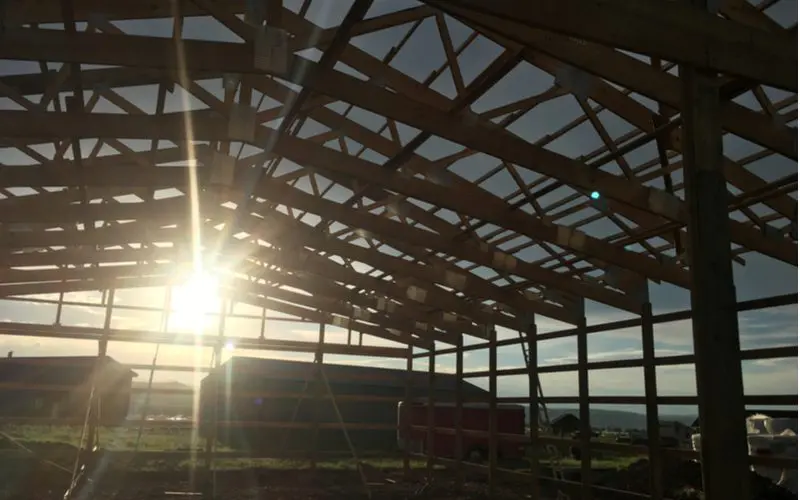
Skye Watts/Shutterstock
Pole barn builds are cost-effective and relatively fast projects. To better gauge pricing, consider some of the more common costs when building any type of structure.
Location and Landscape
As stated, where you put your pole barn and the site’s surroundings significantly impact the cost.
The build’s stabilization depends on the hold of your posts in the ground. So aspects such as soil texture impact the total cost.
Siding
Siding has a range of prices, with an average being between $5,000 and $15,000.
Post-frame barns use wood siding (an average of $3–$10 per square foot) or aluminum siding ($5–$12). Wood is less expensive, but aluminum is the go-to.
Aluminum lasts longer, can withstand harsher weather, and isn’t subject to threats to wood, including aging and infestation. The material is quite reliable when storing automobiles and equipment.
Roofing
A kit might include a shingle or aluminum roof. If one is not included, expect to spend up to $10,000 to install the roof.
The benefit of using a contractor is knowing you’re getting professional production and a guarantee of the work.
Insulation
If you have livestock, plan to use the building as a residence, or use it for the storage of sensitive materials, you might need insulation.
You might be able to lower the price point if you use siding with built-in insulation.
Flooring
Most professionals agree that the best flooring for a pole barn is concrete. The material’s respected for its lifespan (50+ years) and its pet-friendliness.
Concrete reduces allergens, requires minimal maintenance, and is an option for any budget.
Adding a Loft or Living Quarters
If you’re using the space for more than work, there are a range of options. Common costs include:
- Blown-in insulation. $800-$1,500 based on the project
- Installation of electrical wiring. $1,000-$3,000, including the panel (does not include the cost of an electrician)
- Plumbing. A two-day job can range between $45 and $200 an hour
- Window installation. Depending on the number and type of window, $2,500–$7,500
- Drywall. Based on square footage, you’re looking at $1,000–$2,500
- Staircases and railings. Up to $3,000
Windows and Doors
Windows shouldn’t be dismissed just to save costs. Windows are beneficial in reducing energy costs, accessing natural light, and providing a source for cooling the environment.
Your unit might only need basic garage doors ($700–$1,400). Additional doors can range from $500-$2,000.
Painting
Paint gives your pole barn a nice appearance. But it will also serve as a layer that protects the structure from threats such as the weather.
Painting metal siding can fall in the $400–$1,500 range, while painting wood siding costs $700–$2,000.
DIY Pole Barn Cost
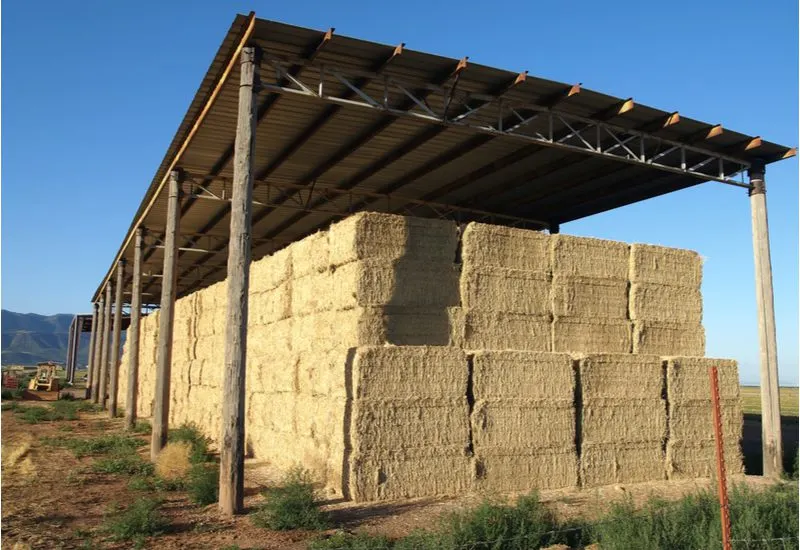
Andrew Orlemann/Shutterstock
If you’re confident with your building skills, you might take a shot at a do-it-yourself pole barn building kit.
Buying a kit requires stringent due diligence. Some kits might not have engineering plans. Those plans are necessary to get a building permit in many regions.
Here are general prices for kits based on size:
- 500–800 square feet. Considered a small pole building, $19,000-$25,000
- 800-2,000 square feet. Considered a medium pole building, $25,000–$45,000
- 2,000–10,000 square feet. Considered a large pole building ($45,000–$175,000)
Frequently Asked Questions
Here are some of the most frequently asked questions about average pole barn costs and whether they’re worth the investment:
What’s the Life Expectancy of Pole Barns?
Properly installed and depending on aspects such as location and maintenance, a pole building can last 40-80 years.
What Kind of Maintenance Does a Pole Barn Need?
To prevent damage, you should spend a little extra on pressure-treated wood. Engineered with chemicals, this material keeps bacteria, fungi, and other pollutants out.
There also are options to protect the barn posts from moisture, which will keep posts dry and strong for years.
Can I Get a Mortgage on a Pole Barn?
Most lenders won't provide construction loans for pole barns, nor do they rush to offer conventional mortgages for pole barn houses.
Can I Insure a Pole Barn?
Yes. But each insurer might have unique criteria for qualification.
Can a Pole Barn Retain its Value?
Upgrading to a pole barn does not necessarily increase a property's value. Still, you always have the chance to escalate your property's marketability.
Like any property, a well-managed and attractive building that complements the landscape will always have curb appeal.
Are Pole Barns Energy-Efficient?
Post-frame buildings are highly sustainable and efficient, but the construction and tech applied to the project influence those benefits.
Look for reliable energy resources to ensure a durable, practical, and economical build.
Closing Thoughts
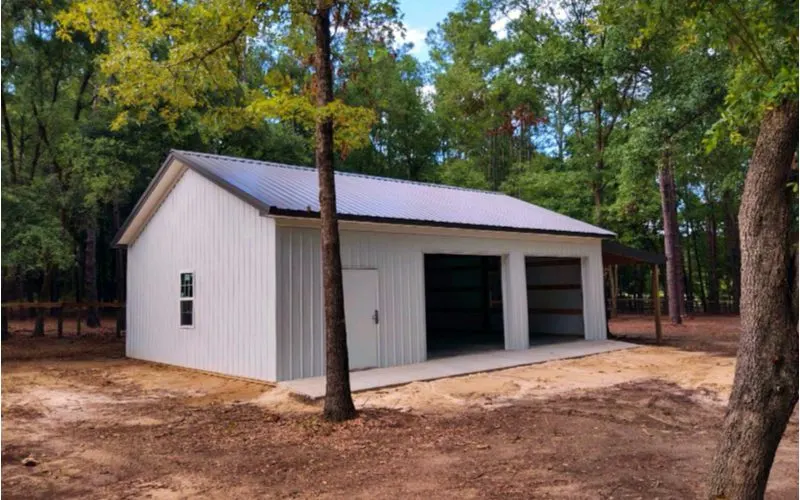
3queens_aJack/Shutterstock
The cost of pole barns varies. We hope the information above helps you make an educated decision about what works best for you and how a pole barn could improve your property and workflow.

